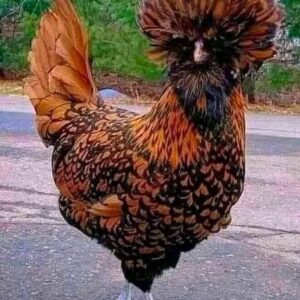The Russian Orloff chicken is a rare and fascinating breed with a rich history and distinct characteristics. Here’s everything you should know about this unique and hardy breed:
Characteristics of Russian Orloff Chickens:
- Appearance:
- Russian Orloffs are a medium-sized breed with a distinct look. They have a broad, muscular body and a relatively upright posture. Their head is large and often has a comb that’s somewhat unusual in appearance, typically a single or pea comb (sometimes even a rose or cushion comb).
- They have a unique feathering pattern, often black, red, or a mix of both, with some individuals having speckled or multi-colored feathers.
- Their tail is usually medium to long and carried at an angle, which adds to their elegant appearance.
- Hardiness:
- One of the standout features of the Russian Orloff is its hardiness. Originally developed in Russia, the breed was designed to withstand harsh climates. As a result, Orloffs are cold-hardy and can handle the winter months better than many other breeds.
- This hardiness makes them well-suited for regions with cold temperatures and extreme winters. However, they can also adapt to warmer climates if given access to shade and water during the hotter months.
- Temperament:
- Russian Orloffs are generally known for being calm and docile. They are not overly skittish or aggressive, making them good for backyard flocks and families.
- However, they can sometimes be a bit reserved or shy, particularly if they aren’t accustomed to humans. With gentle handling, they can become quite friendly and tame.
- They are often described as being independent and not overly social with other chickens, but they generally get along well within a mixed flock.
- Egg Production:
- Russian Orloffs are moderate layers, typically producing about 150-200 medium-sized brown eggs per year.
- While they are not as prolific as some of the more well-known layers like Leghorns or Rhode Island Reds, they provide a decent number of eggs, especially considering their hardy nature and smaller size.
- Feeding & Care:
- Like many hardy breeds, the Russian Orloff is not particularly demanding when it comes to feeding and care. They thrive on a balanced diet of commercial feed, supplemented with kitchen scraps and occasional treats.
- Orloffs are also good foragers, meaning they can be allowed to roam and search for food, which helps in their overall well-being.
- Lifespan:
- The average lifespan of a Russian Orloff is around 5-8 years, though, with proper care, they can live longer.
- They tend to remain relatively healthy if kept in appropriate conditions and given proper nutrition and care.
- Purpose:
- Russian Orloffs are considered a dual-purpose breed, raised for both meat and eggs. Their meat is known to be tender and flavorful, making them a good option for small homesteads or farms.
- They were originally bred for hardiness and meat production, with their eggs being a secondary benefit.
- History:
- The Russian Orloff originated in Russia in the 18th century and is believed to have been a result of crossing Oriental fowl with local Russian birds. Over time, the breed became popular for its cold tolerance and meat quality.
- Though the breed was once more common in Eastern Europe, it has become quite rare today, particularly outside of Russia and parts of Eastern Europe.
- Varieties:
- The breed comes in several color varieties, including black, red, and even gold. The plumage can also feature a mix of colors, which makes them visually interesting and diverse.
Summary:
The Russian Orloff is a hardy, dual-purpose breed with a calm temperament and moderate egg production. They are excellent for colder climates due to their resilience in harsh winters and are a great addition to anyone looking for a unique, historic breed that provides both eggs and meat. While not the most prolific layers, their distinctive appearance and gentle nature make them an attractive choice for backyard flocks, especially those looking to add a rare breed.








Reviews
There are no reviews yet.